Task 8. Expected: List Files in Vertical Column Layout. Try Again.
Lesson 8: Baseline
Now that you lot've create the WBS structure of your project and the planning process is nigh finished, y'all can set a baseline for your project. You can set a baseline after you finished planning your project or y'all can set one afterward you finished a critical stage of your project and the baseline will comprise information about the tasks, resources and assignments within their phase. The project baseline should ever come in-betwixt the planning stage and the start of the projection. Yous should simply re-baseline when you have major changes in your project such every bit: delays, overrun of budget or loss of key resources. The right place in time to exercise the first baseline is when the initial planning is washed and the budget is approved. Set a baseline for your project so that yous can track its progress against the original projection plan. A baseline is a reference point for the project schedule.
A project baseline is an initial snapshot of your schedule when you first save your project information to track progress and compare your updates. Baselines assistance yous visualize and attain your project schedule, work and toll objectives. It is very useful specially in the case of small-scale projects that use agile development, and so they demand to know in each week which is the deviation between the original programme and the current status.
A baseline is a static re-create of plan information that's compared with actual and current data. It refers to a fix of data near project that represents state earlier the work actually began. Baselines helps you compare actual vs. planned. Baseline your schedule means taking a copy of your schedule and set up aside for comparison afterward on. It is a snapshot/a picture of your project at a particular moment in time.
A baseline saves nearly xx pieces of data, including totals data for tasks, resources, and assignments. It volition essentially store 5 things: price, piece of work, elapsing, outset date and terminate date. In Project Programme 365, a baseline is a copy of the Outset, End, Piece of work, and Price for all the Resources and Assignments, plus Duration for all the tasks in your projection. When you lot do a baseline you save the following data about the project at that specific indicate in time:
- Tasks: Duration, Offset and Finish dates, Work, Toll.
- Resources: Work, Cost, Commencement and Finish.
- Assignments: Start and Cease dates, Work, Costs.
Together, this information represents the land of your plan at the fourth dimension the baseline is saved. The baseline will exist a valuable tool to use as your project progresses, and afterwards it completes, to compare how the real life of your project matched up with what yous projected during the planning stages. Baselines are really important to constitute in society to give you a point in fourth dimension to reflect upon and a area where you tin refer back to make up one's mind whether or not your assessments are correct, that the durations yous've placed in terms of the tasks time are correct and if the costs are correct and so that information technology helps you improve your estimating for future projects.
A baseline is not a dissever file. When you save a baseline, Project Plan 365 merely copies the information in scheduled fields to the baseline fields. For example, when you save a baseline, Project Plan 365 copies the information from the Start and Stop fields into the Baseline Start and Baseline Finish fields.
The process of tracking baselines in Project Program 365 is quite simple. This involves using the Projection Statistics dialog, employ Baseline table to Tracking Gantt and add baseline columns in a task view. Initially all the baseline columns are empty until you save a baseline. Once a project'southward baseline data has been saved, information technology can exist used to clarify projection performance. Tracking Gantt is a type of Gantt Chart view, that is designed to compare baseline dates and eventually show all these differences. The Tracking Gantt allows you to view changes to the baseline schedule graphically and to easily compare the project schedule against the initial programme. The variance between the task bars is easy to runway. Initially when nada is updated, the confined are the same, they friction match each other, but when y'all first updating your plan, yous'll notice slippage if you lot come behind schedule.
 Practise
Practise
1. Now that the schedule is finished at least in its planning stages, allow's create a baseline for the current project. When dealing with baseline, it is recommended to utilize the Tracking Gantt view. To switch to this view, click on Tracking Gantt from the left View Bar.

2. This view, chosen Tracking Gantt, is a type of Gantt Chart, that is designed to compare baseline dates and allows you lot visually see these differences. By using the Tracking Gantt, you can compare progress past comparing baseline and scheduled. In the right side part, next to each taskbar you may notice percent values, which represent the % complete value of each task. And so far, it isn't entered whatsoever progress for the tasks in the project, and as you might meet, yous have but 0% values displayed to the right of each taskbar.
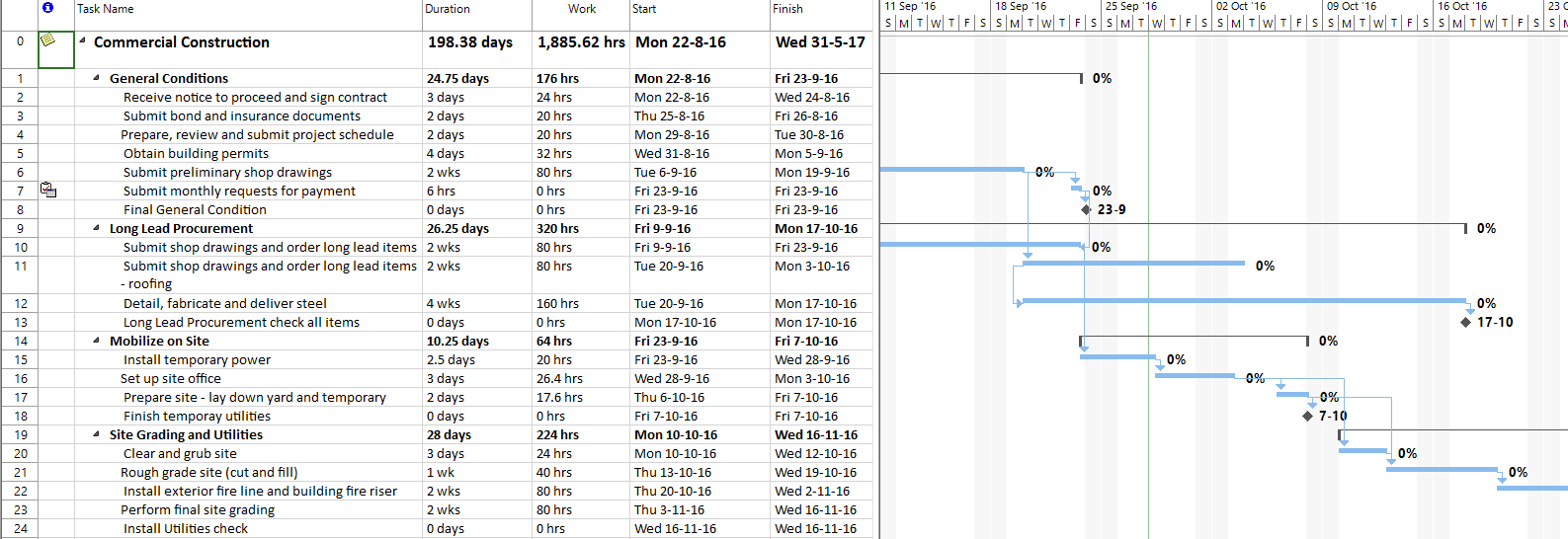
3. In the left side, modify the tabular array which is currently applied. From the Projection bill of fare, click on Tabular array, and then select the Variance table.
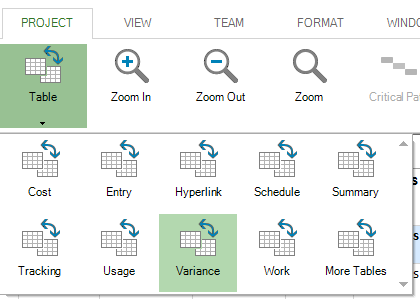
The Variance table shows start and finish dates for both scheduled information and baseline data, making it possible to evaluate your prediction of how the project would progress (baseline) by comparison that prediction with how the project is in fact progressing (actual). You may need to resize some columns to reveal more than content of them.
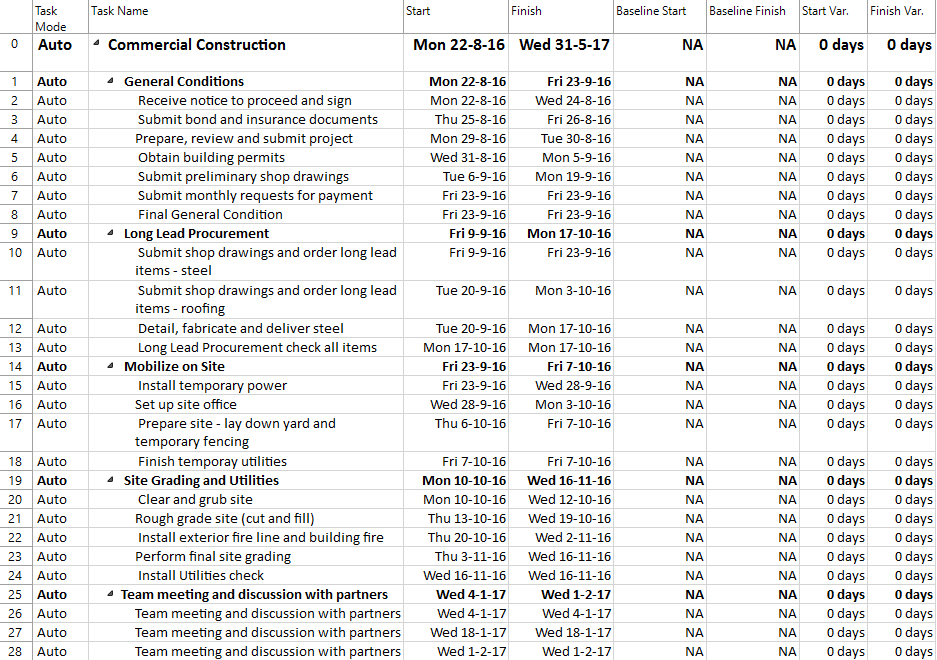
Every bit yous may notice, since it isn't set nonetheless any baseline for the schedule, in the Baseline Start and Baseline Finish columns there is nothing filled yet. Yous see displayed NA, meaning Not Applicative. Permit'south see what happens when you lot set a baseline.
4. At present, let's create a baseline for the electric current projection. To set a baseline in your schedule, head to the Project menu and simply press on Ready Baseline option, or alternatively printing on the arrow below the Set up Baseline pick and and then choose Gear up Baseline from the drop-down list.


5. Notice that the Set Baseline dialog appears that allows you to either set the Baseline for the Unabridged Project or for Selected Tasks.

six. In the Set up Baseline dialog, select the Entire Project option to ready the Baseline for the whole project and click OK.
Once you've pressed on OK, notice that in the left side table, these two columns will go populated with values. In fact, these correspond duplicated values of the planned outset and finish dates and it but copied them in the Baseline Starting time and Baseline Stop columns. When yous fix a baseline is like taking a snapshot of your schedule project at a particular moment in time. Project Program 365 simply copies the information in scheduled fields to the baseline fields.
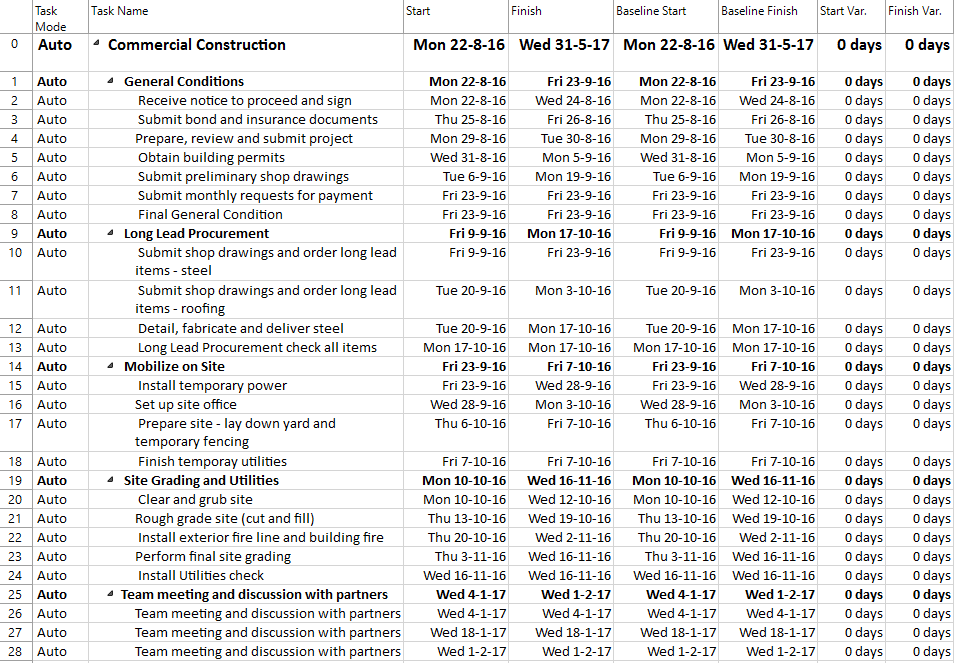
7. You can likewise set the Baseline only for selected tasks. To do so, select the tasks y'all want and then become to the Project menu and simply press on Gear up Baseline option. In the Prepare Baseline dialog select Selected tasks and click the OK push button.

Find that in the left side tabular array, only for the selected tasks the two columns will get populated with values.

But for now, let'south leave the Baseline set for the Unabridged Project.
8. Similar data volition be displayed if you change the table in the left to Baseline, which helps you lot to view the baseline data of the project that was just saved. Click on Table selection under Project menu, and then select More than Tables. From the opened dialog select Baseline.
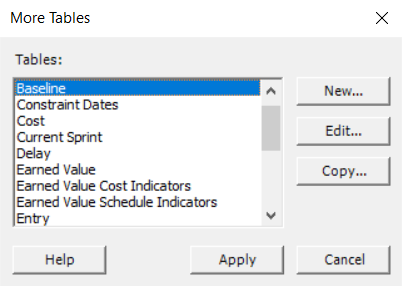
A baseline is a copy of the Offset, Finish, Work, and Cost for all the Resources and Assignments, plus Duration for all the Tasks in your project.
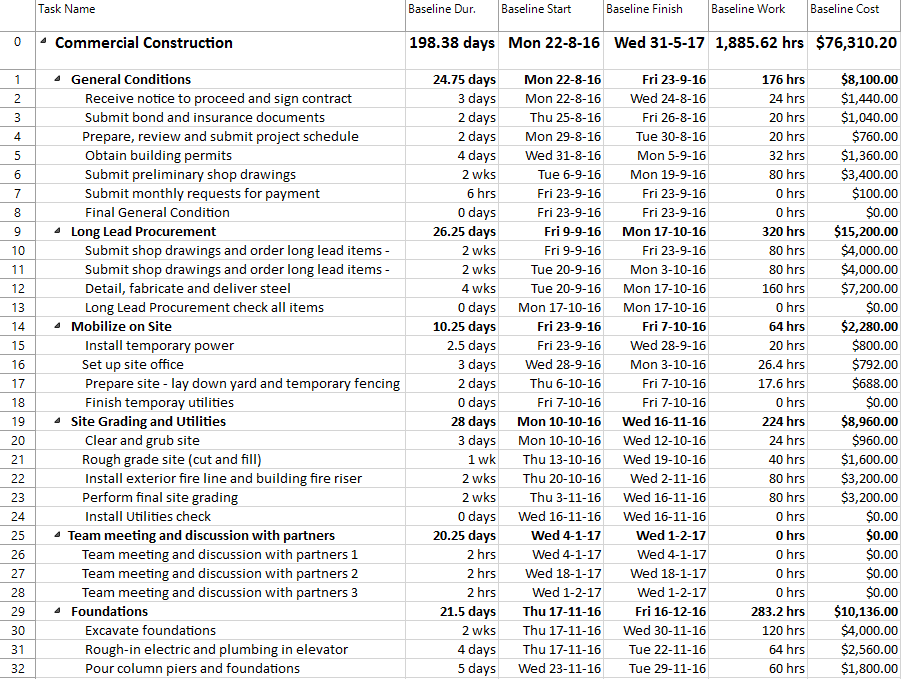
9. Insert in this left table the Duration column by right-clicking on Baseline Outset cavalcade and choosing Insert Cavalcade from the contextual menu. In the Column Definition dialog choose the Duration field.
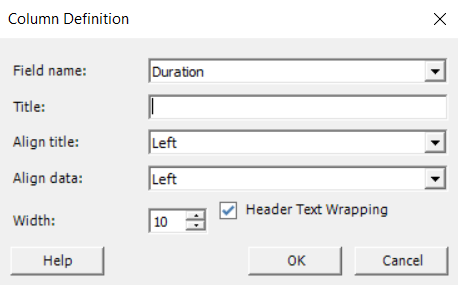
Notice that currently, for instance, the values in the Baseline Elapsing column are an exact copy of the values from the Duration column.
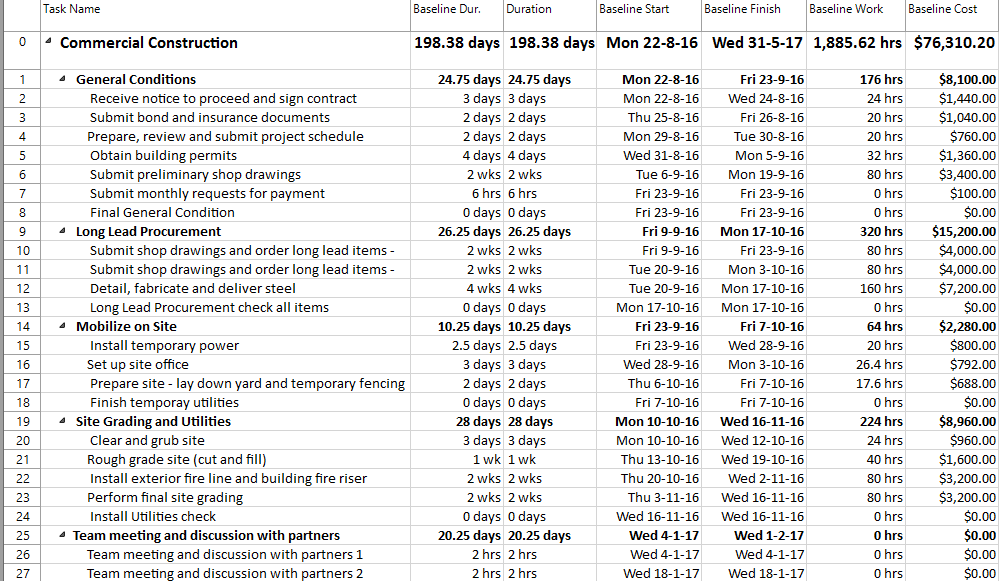
ten. In the correct side of Tracking Gantt view, yous may notice some grey bars that come underneath. These are the Baseline bars. Now, the Tracking Gantt view displays two task bars, one on acme of the other, for each task. The lower bar shows baseline beginning and finish dates, and the upper bar shows scheduled kickoff and stop dates. Once the baseline is set, any changes in the program that is different from the baseline will become obvious and firsthand, helping yous to perform an analysis of the schedule. Now, initially when nil is updated, the bars are the aforementioned, they match each other, just when you start updating your plan, you'll notice slippage if you come up behind schedule.
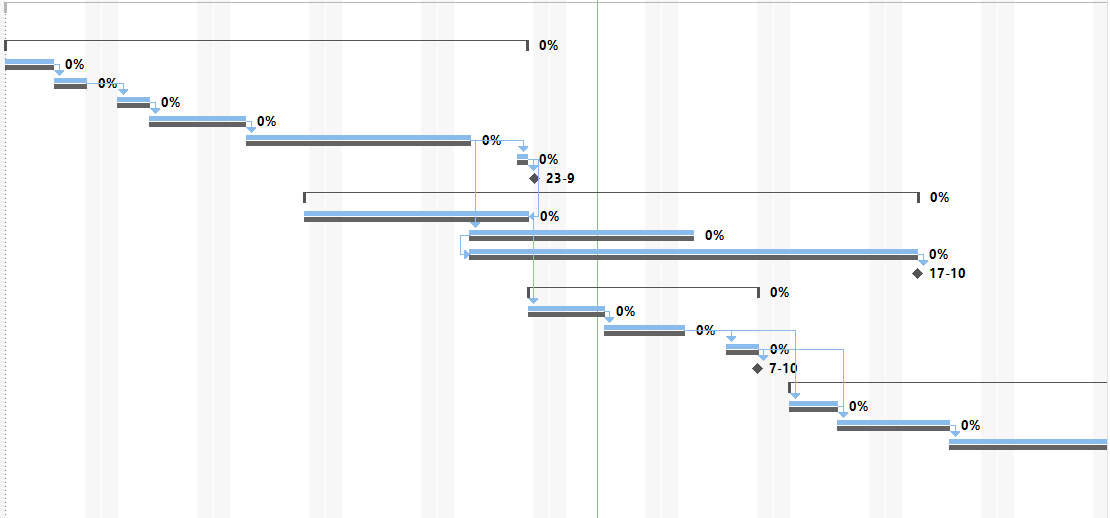
11. If for instance, we accept a week delay for some of our tasks, we can visually run into in the Tracking Gantt the touch of this. For example if a job starts later than what's planned, it is backside schedule. Permit'south presume that "Rough-in electric and plumbing in elevator" task starts later with i week than what was planned. For this, let's change the outset date of this task in a visually manner by using the right nautical chart in this view. Start locate the bar corresponding to this task in the right side. To alter the commencement date of the task, drag the job bar to the correct till it reaches the new start date. During the dragging procedure, a virtual taskbar will be shown, guiding you through the modify pace. Dragging the taskbar to the correct will cause your task to outset after. After this, notice in the right nautical chart how will expect the two bars, for each task.

Now yous can see some differences between the blue bars on pinnacle and the grey ones underneath, which point the initially scheduled dates saved in the baseline. Note that the grey baseline bars do not move and the other bluish confined testify the resultant slippage:

If you lot alter the table in the left to the Entry table, which is the default one in this view, notice that by changing the start date, a Offset No Earlier Than constraint is added to the "Rough-in electric and plumbing in elevator" chore. This is visually marked in the Indicators cavalcade.

When hovering over the icon shown in the Indicators column, the tooltip will say that the task has ready a constraint, specifying the type and the date of the constraint.

12. Now let'south come back to the Baseline table in the left side of the view. Here we will also insert Outset and Terminate columns. Right-click on Baseline Finish column and select Insert Column from the contextual menu. In the Cavalcade Definition dialog select Offset field. Proceed in the same way and right-click on Baseline Work cavalcade. Select Stop in the Column Definition dialog. In this way, the Start column will be inserted after Baseline Commencement column, and the Finish column will exist placed afterwards the Baseline Terminate columns, to permit for an easier comparing. For the "Crude-in electric and plumbing in elevator" task if we look closer in the Baseline Start and Start columns we discover that their values practise not friction match similar before. A similar state of affairs is for Baseline Finish and Finish columns.

This fact is also confirmed if in the right side panel we hover over the bar for this task and look at the data displayed in the tooltip.
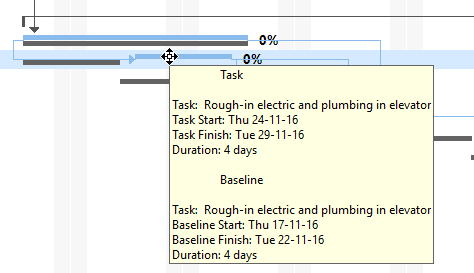
Also that, if you lot change the current table to the Variance one, you may see for this task a value of 5 days for the Start Variance and Finish Variance columns.

13. At present let'southward come back to the Baseline table. Detect that the columns that you lot've previously inserted are kept. Side by side, let's suppose that the "Perform architect's inspection" job was planned to take 5 hrs, but in reality it took 2 days. Then, for this job, in the Duration column blazon two d, pregnant 2 days.

Like previously, since you've prepare a baseline, you tin can compare it with the scheduled and actual information to see how the project is tracking against your initial goals. Permit's notice what happens in the right chart. The red bar at the top changes and increases its size to 2 days duration. But the grayness bar beneath is still consequent and remains to indicate a duration of 5 hrs. Also due to the dependency between tasks the following tasks are rescheduled, causing differences with the dates saved in the baseline, as you might also come across in the right chart.

xiv. Let's come across also what happens with the dates in the left side table. Insert other 2 columns, namely Work and Cost to assess the current land of the schedule in terms of work and price. Drag the vertical divider between the two panels to the right to create more space for the left tabular array. Select the Baseline Cost cavalcade, correct-click on it, select Insert Cavalcade and in the Column Definition dialog choose Work. And so repeat the process once more for the Cost column. Move the Toll cavalcade later Baseline Price past dragging it to the right. If you await in this tabular array at the "Perform builder's inspection" task, you may notice the differences between the Baseline Elapsing and Duration values, and Baseline Finish and Finish values. Also the alter in the current task elapsing draws some changes in the current values for Work and Price, being different from their counterpart values stored in the baseline.
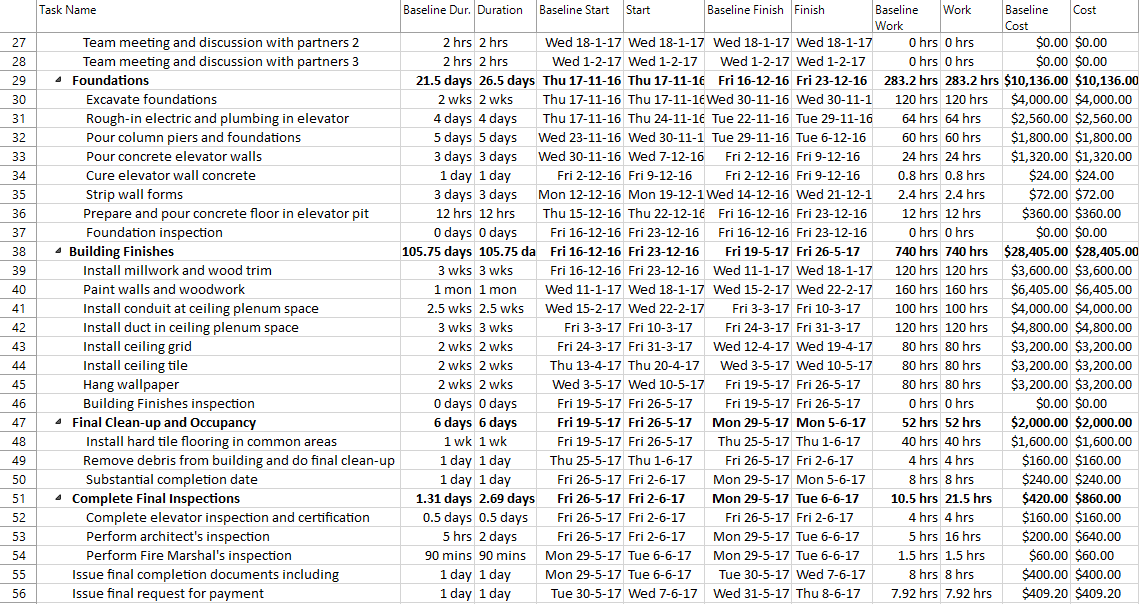
15. Now, that you've set a baseline for your project, you can compare the actual dates to the original planned dates, that were captured in the baseline. In this way, you can utilise the baseline every bit a footing of comparison every bit you track progress of the project. So, let's go at the starting time row corresponding to the project summary chore and await at the value for the finish appointment. You meet that now, co-ordinate to the recently adjustments that y'all've fabricated, the project finishes on viii of June, which is different from the date of 31 May the project was planned to terminate on, every bit you run into in the Baseline Finish column. So y'all have a delay of a few days, compared to the initial schedule.

16. Another place where you tin can run into the impact of baseline is in the Statistics dialog. To have a look on it, in the Project menu, press on Project Information, so on Statistics, where you tin see a baseline entry for Commencement, Finish, Elapsing, Work and Cost columns. You tin can likewise notice in the Finish column a variance of 6.38 days for the projection finish date, reflecting the fact that now the project ends after with 6.38 days compared to what was originally planned. Notice likewise the differences betwixt the Current Work and Baseline Work values, as well as for the Price.
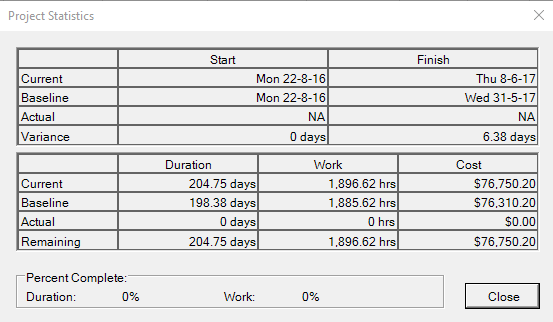
17. If you want to remove the baseline set up in your project, become to the Project menu, press on the arrow down to the Set Baseline option and in the displayed list y'all will see Articulate Baseline.
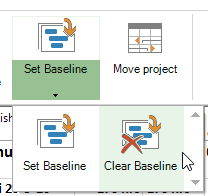
Here you besides have the possibility to remove the Baseline for the entire project or only for selected tasks. In the Clear Baseline dialog select Entire project and click the OK push.

Just if you're satisfied with the current saved baseline, don't delete it.
 Video
Video
If you prefer to see things in action, rather than reading text, watch out this video, which covers some of the topics from this department.
Source: https://www.projectplan365.com/training/lesson-8-baseline/
0 Response to "Task 8. Expected: List Files in Vertical Column Layout. Try Again."
Postar um comentário